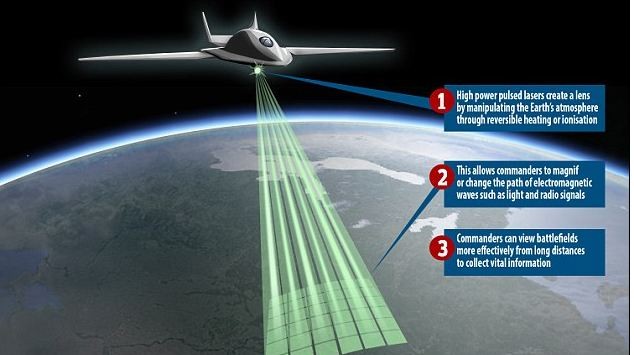A fantastic new type of directed energy laser and lens system will allow the United Kingdom and its allies to protect troops, ships and warplanes from destruction by creating a "deflector shield" that can also be used to spy on an enemy from very long distances.
This dual threat battlefield weapon is called the "Laser Developed Atmospheric Lens" (LDAL) and might become a reality in the next 50 years, said British scientists from BAE Systems plc, the British multinational defense, security and aerospace company that's working on this system.
As a deflector shield, LDAL will protect friendly personnel and equipment from incoming attacks by using high power laser weapons. It works by simulating naturally occurring phenomena and temporarily -- and reversibly -- changes the Earth's atmosphere into lens-like structures to magnify or change the path of electromagnetic waves such as light and radio signals.
BAE described LDAL as a complex and innovative concept that copies two natural phenomenon: the reflective properties of the ionosphere and desert mirages.
The ionosphere is a high-altitude, naturally occurring layer of the Earth's atmosphere that can reflect radio waves. Radio signals bounce off the ionosphere allowing them to travel very long distances through the air and over the Earth's surface.
Desert mirages create realistic illusions that can deceive the human eye. This is because the light from the blue sky is bent or refracted by the hot air near the surface and into the vision of the person looking into the distance.
BAE scientists said LDAL simulates both of these phenomenon by using a high pulsed power laser system and exploiting a physics phenomena called the "Kerr Effect" to temporarily ionize or heat a small region of atmosphere in a structured way.
Mirrors, glass lenses and structures like Fresnel zone plates can all be replicated using the atmosphere, allowing the physics of refraction, reflection, and diffraction to be exploited.
"Working with some of the best scientific minds in the UK, we're able to incorporate emerging and disruptive technologies and evolve the landscape of potential military technologies in ways that, five or ten years ago, many would never have dreamed possible," said Professor Nick Colosimo, BAE Systems' Futurist and Technologist.
LDAL is being developed by scientists at the BAE's military aircraft facility in Warton, Lancashire. It has been evaluated by the Science and Technology Facilities Council (STFC) Rutherford Appleton Laboratory and specialist optical sensors company LumOptica.
"For this evaluation project, STFC's Central Laser Facility team worked closely with colleagues at BAE Systems and by harnessing our collective expertise and capabilities we have been able to identify new ways in which cutting edge technology, and our understanding of fundamental physical processes and phenomena, has the potential to contribute to enhancing the safety and security of the UK," said Prof. Bryan Edwards, leader of STFC's Defense, Security and Resilience Futures Program.



























